
Maasai Mara, also sometimes spelled Masai Mara and locally known simply as The Mara, is a large national game reserve in Narok, Kenya, contiguous with the Serengeti National Park in Tanzania. It is named in honor of the Maasai people, the ancestral inhabitants of the area, who migrated to the area from the Nile Basin. Their description of the area when looked at from afar: "Mara" means "spotted" in the local Maasai language, due to the many short bushy trees which dot the landscape.
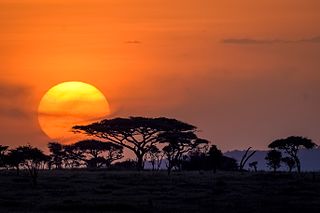
The Serengeti ecosystem is a geographical region in Africa, spanning northern Tanzania. The protected area within the region includes approximately 30,000 km2 (12,000 sq mi) of land, including the Serengeti National Park and several game reserves. The Serengeti hosts the second largest terrestrial mammal migration in the world, which helps secure it as one of the Seven Natural Wonders of Africa, and as one of the ten natural travel wonders of the world.

The Ngorongoro Conservation Area is a protected area and a UNESCO World Heritage Site located in Ngorongoro District, 180 km (110 mi) west of Arusha City in Arusha Region, within the Crater Highlands geological area of northern Tanzania. The area is named after Ngorongoro Crater, a large volcanic caldera within the area. The conservation area is administered by the Ngorongoro Conservation Area Authority, an arm of the Tanzanian government, and its boundaries follow the boundary of the Ngorongoro District in Arusha Region.

The Masai giraffe, also spelled Maasai giraffe, also called Kilimanjaro giraffe, is a subspecies or species of giraffe. It is native to East Africa. The Masai giraffe can be found in central and southern Kenya and in Tanzania. It has distinctive, irregular, jagged, star-like blotches that extend to the hooves. A median forehead lump is usually present in bulls.

Trophy hunting is hunting of wild animals as trophies, with the whole or parts of the hunted animal kept and usually displayed to represent the success of the hunter. The preferred target animal, known as the game, is typically a large or impressively ornamented male, such as one having large horns or antlers. Usually, only some parts of the animal are kept as trophies, although preserving the entire animal via taxidermy is also practised.

Blast fishing, fish bombing, or dynamite fishing is a destructive fishing practice using explosives to stun or kill schools of fish for easy collection. This often illegal practice is extremely destructive to the surrounding ecosystem, as the explosion often destroys the underlying habitat that supports the fish. The frequently improvised nature of the explosives, and undetonated charges, used means danger for fishermen and divers as well, with accidents and injuries.

Sustainable tourism is a concept that covers the complete tourism experience, including concern for economic, social and environmental issues as well as attention to improving tourists' experiences and addressing the needs of host communities. Sustainable tourism emerged as an outcome of preventing the uncontrolled and excessive use of mountain tourism resources and attractions in Sumadija and Western Serbia. Sustainable tourism should embrace concerns for environmental protection, social equity, and the quality of life, cultural diversity, and a dynamic, viable economy delivering jobs and prosperity for all.
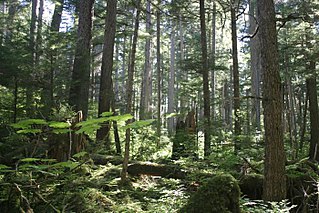
Natural resource management (NRM) is the management of natural resources such as land, water, soil, plants and animals, with a particular focus on how management affects the quality of life for both present and future generations (stewardship).natural resource management

Terrat is a ward and village in the Simanjiro district about 80 km from Arusha in Tanzania. The ward has approximately 14,000 inhabitants. The population in the area is Maasai who regularly gather in the village for its market where animals, cloths, kitchen utensils etc. are sold. The buildings in the village are one-storeyed, mostly cement walled with corrugated iron roofs, scattered at the banks of a small river.
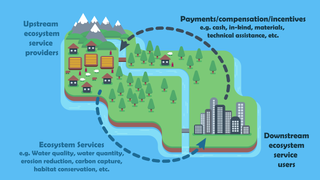
Payments for ecosystem services (PES), also known as payments for environmental services, are incentives offered to farmers or landowners in exchange for managing their land to provide some sort of ecological service. They have been defined as "a transparent system for the additional provision of environmental services through conditional payments to voluntary providers". These programmes promote the conservation of natural resources in the marketplace.

The wildlife of Canada or biodiversity of Canada consist of over 80,000 classified species, with an equal number thought yet to be recognized. Known fauna and flora have been identified from five different kingdoms: protozoa ; chromist ; fungis ; plants ; and animals. Insects account for nearly 70 percent of recorded animal species in Canada.
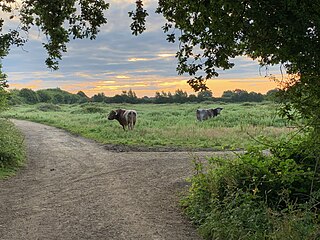
Rewilding, or re-wilding, activities are conservation efforts aimed at restoring and protecting natural processes and wilderness areas. This may include providing connectivity between such areas, and protecting or reintroducing apex predators and keystone species.
Defaunation is the global, local or functional extinction of animal populations or species from ecological communities. The growth of the human population, combined with advances in harvesting technologies, has led to more intense and efficient exploitation of the environment. This has resulted in the depletion of large vertebrates from ecological communities, creating what has been termed "empty forest". Defaunation differs from extinction; it includes both the disappearance of species and declines in abundance. Defaunation effects were first implied at the Symposium of Plant-Animal Interactions at the University of Campinas, Brazil in 1988 in the context of Neotropical forests. Since then, the term has gained broader usage in conservation biology as a global phenomenon.

Ecosystem management is an approach to natural resource management that aims to ensure the long-term sustainability and persistence of an ecosystems function and services while meeting socioeconomic, political, and cultural needs. Although indigenous communities have employed sustainable ecosystem management approaches for millennia, ecosystem management emerged formally as a concept in the 1990s from a growing appreciation of the complexity of ecosystems, as well as humans' reliance and influence on natural systems.
The African Wildlife Foundation (AWF) is the leading international conservation organization focused exclusively on Africa's wildlife and wild lands.
This is a bibliography of ecology.

The Tarangire River is a perennial river located in central Manyara Region in the eastern branch of the East African Rift Valley, within northern Tanzania.
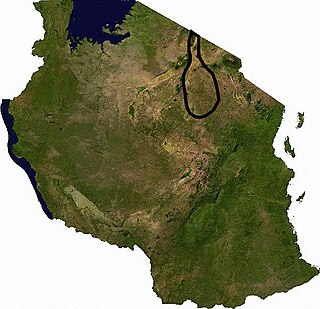
The TarangireEcosystem is a geographical region in Africa. It is located in northern Tanzania and extends between 2.5 and 5.5 degrees south latitudes and between 35.5 and 37 degrees east longitudes.

Kijereshi Game Reserve is a protected area in Tanzania.

Keo Seima Wildlife Sanctuary is a 2,926.9 km2 (1,130.1 sq mi) protected area in eastern Cambodia, located in Mondulkiri and Kratié provinces. The area was first established as Seima Biodiversity Conservation Area in 2002, later becoming Seima Protection Forest in 2009, finally becoming Keo Seima Wildlife Sanctuary in 2016. The site is of national, regional, and global importance for a range of biodiversity, with more than 950 species recorded within the protected area. It is also the ancestral and contemporary home of a large number of the Bunong ethnic group.

















